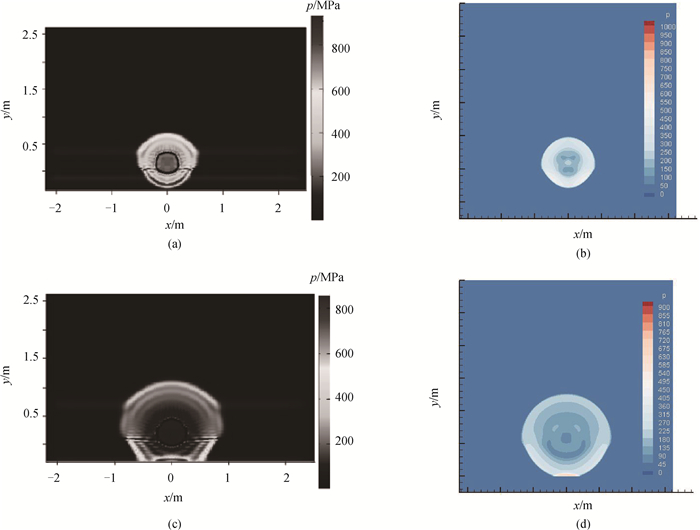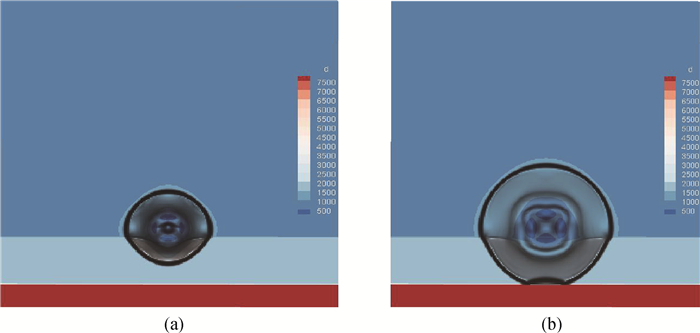计算物理 ›› 2023, Vol. 40 ›› Issue (5): 556-569.DOI: 10.19596/j.cnki.1001-246x.8658
吴宗铎1( ), 满庆洋2, 严谨1, 庞建华3,*(
), 满庆洋2, 严谨1, 庞建华3,*( ), 孙一方1
), 孙一方1
收稿日期:2022-10-27
出版日期:2023-09-25
发布日期:2023-11-02
通讯作者:
庞建华
作者简介:吴宗铎(1984-), 男, 博士, 副教授, 研究方向为激波间断问题数值计算, E-mail: wuzongduo0@aliyun.com
基金资助:
Zongduo WU1( ), Qingyang MAN2, Jin YAN1, Jianhua PANG3,*(
), Qingyang MAN2, Jin YAN1, Jianhua PANG3,*( ), Yifang SUN1
), Yifang SUN1
Received:2022-10-27
Online:2023-09-25
Published:2023-11-02
Contact:
Jianhua PANG
摘要:
研究水下爆炸中的防护层问题, 将爆炸气体、水、防护层或其他材料看成一个混合流场后, 它们的物理状态可以直接用统一形式的Mie-Grüneisen状态方程来表示, 再用Mie-Grüneisen混合模型模拟爆炸气体、水、固态防护层之间的复杂相互作用。计算时, 通过状态方程中的特定参数来区分流体成分的物理特性, 并通过体积分数来区分界面, 同时添加自由进出口边界条件; 计算过程中, 对防护层的效果进行细致研究。研究发现, 防护层的效果取决于材料的冲击阻抗。当冲击波从一种介质进入新介质时, 在新介质冲击阻抗较小的情况下其压力会降低。同时, 进入防护层的冲击波被结构物反射又会形成第二个冲击波。在这个过程中, 对防护层的厚度和距离进行关注, 但是这两个因素并未产生重要影响。
吴宗铎, 满庆洋, 严谨, 庞建华, 孙一方. 三介质Mie-Grüneisen混合模型在水下爆炸防护层问题中的应用[J]. 计算物理, 2023, 40(5): 556-569.
Zongduo WU, Qingyang MAN, Jin YAN, Jianhua PANG, Yifang SUN. Applications of Three-component Mie-GrüNeisen Mixture Model in Underwater Explosion Mitigation Problem[J]. Chinese Journal of Computational Physics, 2023, 40(5): 556-569.
| ρ0/(kg·m-3) | c0/(m·s-1) | s | γ0 | α | 适用范围/GPa | |
| 水 | 1 000 | 1 480 | 2.560, -1.986, 0.227(s1, s2, s3) | 0.5 | 1.0 | 0~120 |
| 铁(Fe-1018)、钢 | 7 850 | 3 574 | 1.920 | 1.69 | 1.0 | 0~270 |
| 聚乙烯塑料 | 915 | 2 900 | 1.481 | 1.644 | 1.0 | 0~50 |
| 砂石 | 1 950 | 2 450 | 1.86 | 1.28 | 1.0 |
表1 部分材料的Mie-Grüneisen状态参数
Table 1 Mie-Grüneisen state parameters for some materials
| ρ0/(kg·m-3) | c0/(m·s-1) | s | γ0 | α | 适用范围/GPa | |
| 水 | 1 000 | 1 480 | 2.560, -1.986, 0.227(s1, s2, s3) | 0.5 | 1.0 | 0~120 |
| 铁(Fe-1018)、钢 | 7 850 | 3 574 | 1.920 | 1.69 | 1.0 | 0~270 |
| 聚乙烯塑料 | 915 | 2 900 | 1.481 | 1.644 | 1.0 | 0~50 |
| 砂石 | 1 950 | 2 450 | 1.86 | 1.28 | 1.0 |
| 介质数量 | 多相模型[ | 五方程模型[ | Mie-Grüneisen混合模型 |
| 2 | 7个方程,1个逼近关系式 | 5个方程,1个逼近关系式 | 6个方程 |
| 3 | 11个方程,2~3个逼近关系式 | 7个方程,2~3个逼近关系式 | 7个方程 |
| 4 | 15个方程,3~6个逼近关系式 | 9个方程,3~6个逼近关系式 | 8个方程 |
表2 不同数值模型需要方程数的比较
Table 2 Comparison of equations required in different numerical models
| 介质数量 | 多相模型[ | 五方程模型[ | Mie-Grüneisen混合模型 |
| 2 | 7个方程,1个逼近关系式 | 5个方程,1个逼近关系式 | 6个方程 |
| 3 | 11个方程,2~3个逼近关系式 | 7个方程,2~3个逼近关系式 | 7个方程 |
| 4 | 15个方程,3~6个逼近关系式 | 9个方程,3~6个逼近关系式 | 8个方程 |

图6 砂石中冲击波反射后的压力分布(a) 0.2 ms时刻Ref.[28]计算结果;(b) 0.2 ms时刻本文计算结果;(c) 0.4 ms时刻Ref.[28]计算结果;(d) 0.4 ms时刻本文计算结果
Fig.6 Pressure distribution of shock wave in sand after reflection (a) Ref.[28]'s results at 0.2 ms; (b) our results at 0.2 ms; (c) Ref.[28]'s results at 0.4 ms; (d) our results at 0.4 ms

图7 冲击波作用于砂石上不同时刻的密度分布(a) 0.2 ms时刻本文计算结果; (b) 0.4 ms时刻本文计算结果
Fig.7 Density distribution at different time instants with the impact of the shock wave on sand (a) our results at 0.2 ms; (b) our results at 0.4 ms
| ρ0/(kg·m-3) | 冲击波运动时间/ms | 冲击波运动距离/m | 冲击阻抗SI/(MPa·m·s-1) | |
| 钢铁 | 7 800 | 0.138 | 0.5 | 28.26 |
| 砂石 | 1 950 | 0.227 | 0.5 | 4.30 |
| 聚乙烯塑料(实心) | 915 | 0.139 | 0.5 | 3.29 |
| 聚乙烯塑料(空心) | 750 | 0.172 | 0.5 | 2.33 |
| 水 | 1 000 | 0.172 | 0.6~0.075 × 2 | 2.62 |
表3 4种介质受冲击阻抗对比
Table 3 The shock impedance contrast of the four mediums under impact
| ρ0/(kg·m-3) | 冲击波运动时间/ms | 冲击波运动距离/m | 冲击阻抗SI/(MPa·m·s-1) | |
| 钢铁 | 7 800 | 0.138 | 0.5 | 28.26 |
| 砂石 | 1 950 | 0.227 | 0.5 | 4.30 |
| 聚乙烯塑料(实心) | 915 | 0.139 | 0.5 | 3.29 |
| 聚乙烯塑料(空心) | 750 | 0.172 | 0.5 | 2.33 |
| 水 | 1 000 | 0.172 | 0.6~0.075 × 2 | 2.62 |
| 1 |
|
| 2 |
金泽宇. 抗冲覆盖层水下爆炸计算方法研究[D]. 上海: 上海交通大学, 2017.
|
| 3 |
GLASCOE L, McMICHAEL L, VANDERSALL K, et al. Underwater blast experiments and modeling for shock mitigation[C]. 14th International Detonation Symposium, 2010.
|
| 4 |
贾虎, 沈兆武. 空气隔层对水中冲击波的衰减特性[J]. 爆炸与冲击, 2012, 32(1): 61- 66.
|
| 5 |
DOI |
| 6 |
DOI |
| 7 |
DOI |
| 8 |
孙远翔, 田俊宏. 近场水下爆炸载荷及舰船结构动态响应研究综述[J]. 舰船科学技术, 2019, 41(11): 1- 8.
|
| 9 |
TAYLOR G I. The pressure and impulse of submarine explosion waves on plates[G]//The Scientific Papers of Sir Georey Ingram Taylor. Cambridge: Cambridge University Press, 1963: 287-303.
|
| 10 |
罗泽立, 周章涛, 毛海斌, 等. 水下爆炸强冲击波与平板结构相互作用的理论分析方法[J]. 高压物理学报, 2017, 31(4): 443- 452.
|
| 11 |
|
| 12 |
王成, SHUC. 爆炸力学高精度数值模拟研究进展[J]. 科学通报, 2015, 60(10): 882- 898.
|
| 13 |
刘铁钢, 许亮. 模拟多介质界面问题的虚拟流体方法综述[J]. 气体物理, 2019, 4(2): 1- 16.
|
| 14 |
|
| 15 |
DOI |
| 16 |
|
| 17 |
姚成宝, 付梅艳, 韩峰, 等. 欧拉坐标系下具有锐利相界面的可压缩多介质流动数值方法研究[J]. 力学学报, 2020, 52(4): 1063- 1079.
|
| 18 |
|
| 19 |
|
| 20 |
|
| 21 |
于明. 固体炸药爆轰与惰性介质相互作用的一种扩散界面模型[J]. 爆炸与冲击, 2020, 40(10): 110- 121.
|
| 22 |
|
| 23 |
梁姗, 刘伟, 袁礼. 七方程可压缩多相流模型的HLLC格式及应用[J]. 力学学报, 2012, 44(5): 884- 895.
|
| 24 |
|
| 25 |
|
| 26 |
|
| 27 |
|
| 28 |
姚熊亮, 陈娟, 张阿漫, 等. 基于SPH方法的二维水下爆炸冲击载荷计算[J]. 哈尔滨工程大学学报, 2010, 31(10): 1303- 1311.
|
| 29 |
|
| 30 |
|
| 31 |
LEE E, FINGER M, COLLINS W. JWL equation of state coefficients for high explosives, UCID-16189[R]. Livermore: Lawrence Livermore National Laboratory, 1973.
|
| 32 |
|
| 33 |
|
| 34 |
|
| 35 |
|
| 36 |
|
| 37 |
高飞, 邱艳宇, 王明洋, 等. 基于孔隙演化的砂土冲击绝热关系研究[J]. 振动与冲击, 2017, 36(17): 134- 140.
|
| 38 |
|
| [1] | 蔡洪波, 许育培, 姚沛霖, 张恩浩, 黄翰霄, 朱少平, 贺贤土. 混合流体-PIC物理建模及其在激光聚变中的应用[J]. 计算物理, 2023, 40(2): 159-168. |
| [2] | 张文帅, 蔡洪波, 张恩浩, 杜报, 邹士阳, 朱少平. 马赫数对等离子体碰撞冲击波结构的影响———全动理学模拟研究[J]. 计算物理, 2023, 40(2): 199-209. |
| [3] | 颜子翔, 康炜, 张维岩, 贺贤土. 温稠密物质状态方程的路径积分蒙特卡罗方法研究进展[J]. 计算物理, 2023, 40(2): 258-274. |
| [4] | 骆庆群, 李建素. 基于气液混合层的吸附气体稳定性机理[J]. 计算物理, 2021, 38(4): 465-469. |
| [5] | 薛社生, 李守先. 正冲击波后固壁表面颗粒的上升运动[J]. 计算物理, 2021, 38(3): 280-288. |
| [6] | 高媛, 梁腾飞. 气-固界面作用物理模型的确定性实现方法[J]. 计算物理, 2021, 38(2): 183-191. |
| [7] | 牛霄, 倪国喜, 马文铧. 自适应多分辨率方法在反应多相流数值模拟中的应用[J]. 计算物理, 2020, 37(6): 639-652. |
| [8] | 王雪梅, 董斌, 朱子亮, 杨俊升. 聚合物分子与官能化纳米管相互作用及扩散特性的分子动力学模拟[J]. 计算物理, 2020, 37(5): 589-594. |
| [9] | 柴国亮, 苏军伟, 王乐. 一种保持二阶精度的反距离加权空间插值算法[J]. 计算物理, 2020, 37(4): 393-402. |
| [10] | 高辉, 高瑞峰, 姚孟君, 张道旭, 彭澄宇, 张莹. 液滴撞击液膜的流热耦合界面追踪方法数值模拟[J]. 计算物理, 2020, 37(4): 422-430. |
| [11] | 钟振, 张腾, 肖文君. 月海盆地区壳-幔界面补偿地形体积估计的球谐算法[J]. 计算物理, 2020, 37(3): 335-340. |
| [12] | 张其黎, 刘海风, 李琼, 宋红州, 张弓木. 氢状态方程的路径积分蒙特卡罗研究[J]. 计算物理, 2019, 36(4): 379-385. |
| [13] | 姚孟君, 尚文强, 张莹, 高辉, 张道旭, 刘佩尧. 倾斜壁面中Kelvin-Helmholtz不稳定性演化数值分析[J]. 计算物理, 2019, 36(4): 403-412. |
| [14] | 许国良, 朱一萍, 方林, 杜阳, 黄晓明. 密封界面微孔结构的三维分形重构技术与泄漏特性[J]. 计算物理, 2019, 36(4): 440-448. |
| [15] | 娄钦, 臧晨强, 王浩原, 李凌. 微通道内不混溶气液两相二氧化碳界面动力学行为的格子Boltzmann研究[J]. 计算物理, 2019, 36(2): 153-164. |
| 阅读次数 | ||||||
|
全文 |
|
|||||
|
摘要 |
|
|||||
版权所有 © 《计算物理》编辑部
地址:北京市海淀区丰豪东路2号 邮编:100094 E-mail:jswl@iapcm.ac.cn
本系统由北京玛格泰克科技发展有限公司设计开发
